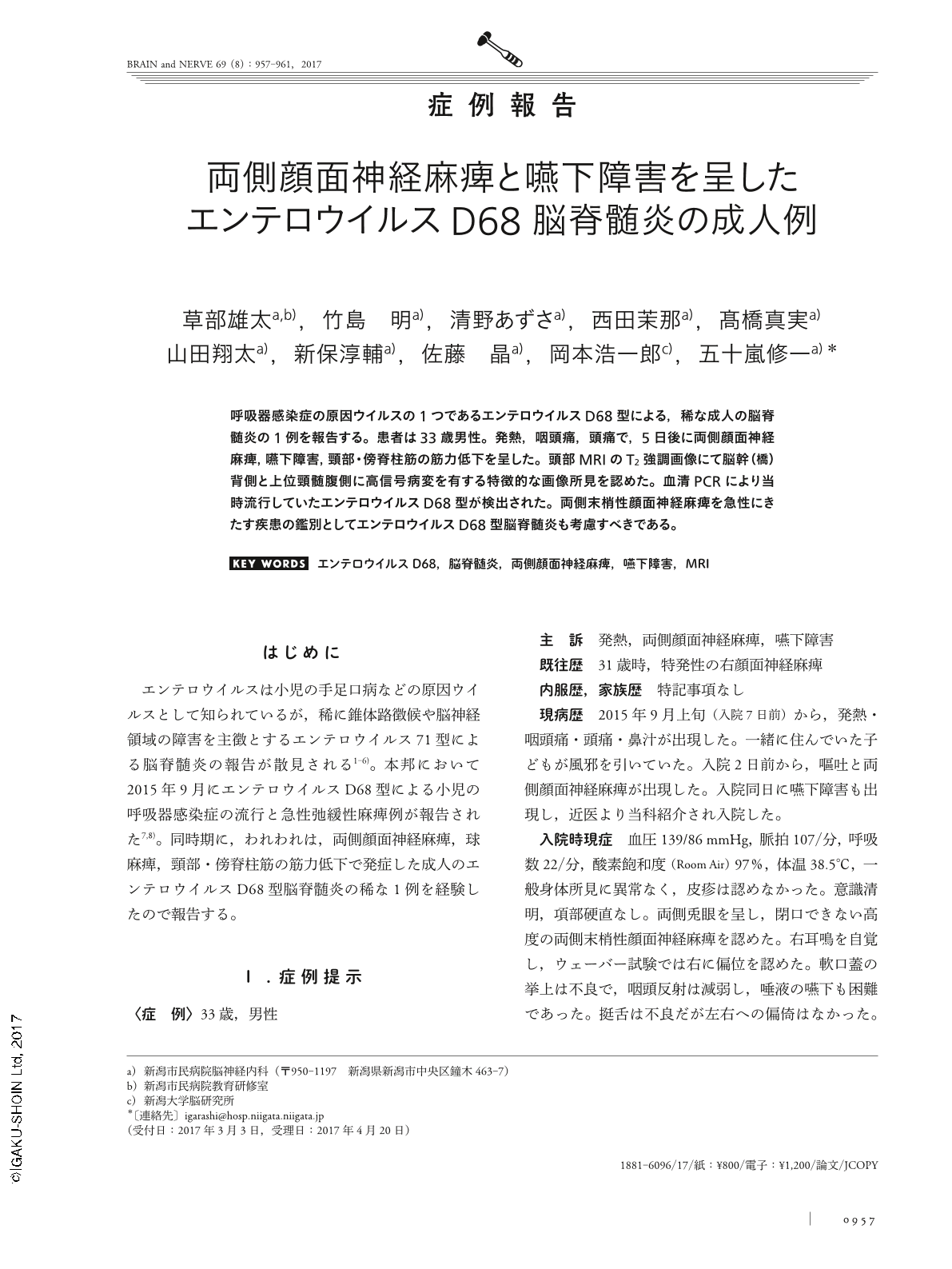5 0 0 0 IR 『解放されたエルサレム』の絵画化 -近世イタリアの女戦士表象を中心に-
- 著者
- 新保 淳乃 シンボ キヨノ SHINBO Kiyono
- 出版者
- 千葉大学大学院人文社会科学研究科
- 雑誌
- 千葉大学人文社会科学研究科研究プロジェクト報告書 (ISSN:18817165)
- 巻号頁・発行日
- vol.279, pp.46-56, 2014-02-28
千葉大学大学院人文社会科学研究科研究プロジェクト報告書 第279集 『歴史=表象の現在』上村 清雄 編"The Presence of History as Representation", Chiba University Graduate School of Humanities and Social Sciences Research Project Reports No.279トルクアート・タッソ(Torquato Tasso, 一五四四-一五九五年)が一五七五年にフェッラーラで発表した『解放されたエルサレム』は、一〇九九年の第一回十字軍を題材に、キリスト教徒の騎士たちがエルサレム奪還をめぐってイスラム勢力を争う壮大な叙事詩である。この叙事詩が発表された十六世紀末のイタリア半島およびヨーロッパ世界は、外からはイスラム教を主とするオスマン帝国の慎重に脅かされ、内からはカトリック教会の失地回復運動とも呼ぶべき対抗宗教改革に突き動かされていた。そうした時代状況を背景に、『解放されたエルサレム』は文学的議論を巻き起こし、その多彩なエピソードは音楽、演劇、絵画、版画、宮廷バレーとさまざまなかたちに翻案された。本稿は、近世イタリアを代表するこの叙事詩の「絵画化」を巡る研究の序論として、研究史を概観し考察の基本的視点を示すものである。研究史の重要なメルクマールとなるのは、一九五四年にフェッラーラで開かれた国際会議である。そこでの報告と議論によって、タッソの詩とそれを生み出した十六世紀後半のフェッラーラを関連付ける基本的枠組みが整えられた。一九五四年の国際会議を契機に、絵画史にとどまらず文学、音楽、演劇を含めた近世の文化全般に視野を広げて、タッソ受容を多角的に論じる場が次々と設けられた。特に一九八五年にフェッラーラで開催された展覧会企画「文学、音楽、演劇、造形芸術のあいだのタッソ」は、その後の領域横断的なアプローチを決定づけたと言える。一九九五年十二月に、タッソ没後四〇〇周年を記念して再びフェッラーラで大規模な国際会議「トルクアート・タッソとエステ家文化…本稿は平成二五年度科学研究費補助金(若手研究B)「近世イタリア絵画における傷病者・看護者増の社会史的表象研究-女戦士像を中心に」(課題番号・25770042、研究代表者・新保淳乃)による研究成果の一部である。
4 0 0 0 OA ペスト危機とジェンダー表象 ─近世イタリア諸都市におけるペスト犠牲者イメージの創出─
- 著者
- 新保 淳乃
- 出版者
- ジェンダー史学会
- 雑誌
- ジェンダー史学 (ISSN:18804357)
- 巻号頁・発行日
- vol.6, pp.29-42, 2010 (Released:2011-10-01)
- 参考文献数
- 25
This paper will examine the visual representations of plague victims as a specific complex of gender and class images. After the 1630 pandemic in Italy, the images of plague victims appeared in the official plague altarpieces commissioned by the city authorities during or just after the epidemic; they served as the collective votive objects (ex. The Neapolitan altarpiece by Luca Giordano for the memorial church of S.Maria del Pianto, ca.1660-61). Analysis of the historical context and visual languages will contribute to a better understanding of the characteristics of this genre and the unstated assumptions lying behind these paintings. In the foreground of the altarpiece, the miserable scene of the lazzaretto or quarantine camp is depicted with a crude realism. The victims in this scene are clearly represented as the Poor. On their naked bodies, one can easily distinguish the plague symptoms. In the 17th-century, the painters following Raphael's model, uniformly chose to insert a motif of a dead mother with a child clinging to her breasts and some male workers carrying the dead. This group became a leitmotif for plague imagery. In sharp contrast to the Virgin Mary and the interceding patron saints, who are depicted as standing or seated gloriously on the clouds, this figure of the dead mother lying at their foot could be read as a sinful daughter of Eve. Also the male workers are represented not as the agents of governance but as those who have a marginal existence exposed to contagion, for they are depicted among the Poor and placed outside the city walls. In conclusion, under the social crisis brought on by the plague, the city authorities tried to keep and reinforce their ideal social and gender systems by visualizing the plague victims as the Other, who should be excluded from their healthy society.
4 0 0 0 IR 未完テクストとしてのアマゾネス : 女戦士表象分析のための研究ノート
- 著者
- 新保 淳乃
- 出版者
- 千葉大学大学院人文公共学府
- 雑誌
- 千葉大学大学院人文公共学府研究プロジェクト報告書 = Chiba University Graduate School of Humanities and Study of Public Affairs Research Project Reports (ISSN:18817165)
- 巻号頁・発行日
- vol.333, pp.9-19, 2018-02-28
2 0 0 0 IR 未完テクストとしてのアマゾネス : 女戦士表象分析のための研究ノート
- 著者
- 新保 淳乃
- 出版者
- 千葉大学大学院人文公共学府
- 雑誌
- 千葉大学大学院人文公共学府研究プロジェクト報告書 = Chiba University Graduate School of Humanities and Study of Public Affairs Research Project Reports (ISSN:18817165)
- 巻号頁・発行日
- no.333, pp.9-19, 2018-02-28
2 0 0 0 OA 近世イタリア諸都市におけるペスト祈願行列の聖母マリア図像 : 疫病平定と癒しの宗教政治学
2 0 0 0 OA 可逆性脳血管攣縮症候群(RCVS)6例の臨床的検討
- 著者
- 宮腰 淑子 五十嵐 修一 永尾 侑平 井上 重宏 佐藤 朋江 関谷 可奈子 新保 淳輔 佐治 越爾 森田 健一 佐々木 修 岡本 浩一郎 佐藤 晶 山崎 元義
- 出版者
- 一般社団法人 日本脳卒中学会
- 雑誌
- 脳卒中 (ISSN:09120726)
- 巻号頁・発行日
- vol.34, no.1, pp.8-15, 2012-01-25 (Released:2012-01-27)
- 参考文献数
- 19
- 被引用文献数
- 1
【背景および目的】可逆性脳血管攣縮症候群(reversible cerebral vasoconstriction syndrome; RCVS)は,雷鳴頭痛を主徴とし,脳血管に可逆性の分節状攣縮を認める疾患である.本疾患の臨床経過と画像所見の経過の検討を目的とした.【方法】2004年6月から2010年12月までに当科にRCVSの診断で加療を行った6例について検討した.【結果】発症年齢は39-53歳(平均44歳)で,女性が4例,男性が2例であった.全例に雷鳴様頭痛を認めた.3例が脳卒中を発症し,全例が女性であった.脳出血が1例,くも膜下出血と脳出血との合併例が2例であった.ベラパミルが5例に投与され,症状改善がみられたが,1例に片麻痺の後遺症を残した.【結論】突然の激しい頭痛を訴える患者を診察する際には,RCVSを鑑別に含める必要がある.
- 著者
- 草部 雄太 竹島 明 清野 あずさ 西田 茉那 髙橋 真実 山田 翔太 新保 淳輔 佐藤 晶 岡本 浩一郎 五十嵐 修一
- 出版者
- 医学書院
- 雑誌
- BRAIN and NERVE-神経研究の進歩 (ISSN:18816096)
- 巻号頁・発行日
- vol.69, no.8, pp.957-961, 2017-08-01
呼吸器感染症の原因ウイルスの1つであるエンテロウイルスD68型による,稀な成人の脳脊髄炎の1例を報告する。患者は33歳男性。発熱,咽頭痛,頭痛で,5日後に両側顔面神経麻痺,嚥下障害,頸部・傍脊柱筋の筋力低下を呈した。頭部MRIのT2強調画像にて脳幹(橋)背側と上位頸髄腹側に高信号病変を有する特徴的な画像所見を認めた。血清PCRにより当時流行していたエンテロウイルスD68型が検出された。両側末梢性顔面神経麻痺を急性にきたす疾患の鑑別としてエンテロウイルスD68型脳脊髄炎も考慮すべきである。
- 著者
- 新保 淳乃
- 出版者
- 明治学院大学言語文化研究所
- 雑誌
- 言語文化 (ISSN:02881195)
- 巻号頁・発行日
- no.29, pp.119-145, 2012-03
【特集】シンポジウム「西洋美術とジェンダー ―視ることの制度」
1 0 0 0 OA イヌ回虫性脊髄炎の1例
- 著者
- 石原 智彦 小澤 鉄太郎 根本 麻知子 新保 淳輔 五十嵐 修一 田中 惠子 西澤 正豊
- 出版者
- 一般社団法人 日本内科学会
- 雑誌
- 日本内科学会雑誌 (ISSN:00215384)
- 巻号頁・発行日
- vol.96, no.1, pp.141-143, 2007 (Released:2009-12-01)
- 参考文献数
- 8
イヌ回虫性脊髄炎は幼虫移行症の一つであり,まれな神経感染症である.症例は左半身のしびれ感にて発症した21歳女性で,頻回に生の牛レバー食歴があった.脊髄MRIで第4~8胸椎レベルに病変を認め,脳脊髄液中の好酸球出現と血清IgE上昇を認めた.血清,脳脊髄液中のイヌ回虫抗体価上昇を認め,イヌ回虫性脊髄炎と診断した.アルベンダゾールの内服で臨床症状は改善し,抗体価も低下した.脊髄炎の鑑別診断の一つにイヌ回虫性脊髄炎も考慮すべきと考え,報告する.
- 著者
- 白畑 知彦 新保 淳 北山 敦康
- 出版者
- 愛知教育大学大学院・静岡大学大学院教育学研究科 共同教科開発学専攻
- 雑誌
- 教科開発学論集 (ISSN:21877327)
- 巻号頁・発行日
- vol.3, pp.181-188, 2015-03-31
本共同教科開発学専攻では、教員養成をおこなう上でこれまで別々に捉えられていた感のある3つの領域、教科専門、教科教育、教職専門を融合し、新たな学問領域を構築しようとしている。このような特色を持つ本専攻と、他大学の「博士(教育学)」課程の教育・運営方針を比較することで、本専攻の今後の方向性を考える一助とする。白畑、新保、北山の3名は、2014 年3月、アメリカ合衆国におけるDoctor of Education Program の現状を把握するために、同国カリフォルニア州の3つの大学(南カリフォルニア大学 (USC)、カリフォルニア大学ロサンジェルス校 (UCLA)、カリフォルニア州立大学ロングビーチ校 (CSULB))を視察した。このうち、USC とUCLA の2校でEd.D. Program 担当者と面会し、話を聞くことができた。そのインタビュー内容を紹介する。次に、日本でEd.D.の学位を授与している唯一の大学院である名古屋大学の博士課程について、今津の2 本の論文を考察することで、1)日本における学位の授与規定について、2)日本におけるEd.D.コースの現状について情報提供する。以上の考察に基づき、本専攻の方向性についてもう一度確認することで我々の方向性を確認する。
1 0 0 0 OA 原体験における身体の関わりに関する研究
- 著者
- 新保 淳
- 出版者
- 静岡大学教育学部
- 雑誌
- 静岡大学教育学部研究報告. 教科教育学篇 (ISSN:0286732X)
- 巻号頁・発行日
- vol.32, pp.137-147, 2001-03
1 0 0 0 OA ICカードを利用した電子印紙システム
1 0 0 0 OA 電子印紙システムの設計と実現
- 著者
- 新保 淳 加藤 岳久 才所 敏明
- 雑誌
- 情報処理学会論文誌 (ISSN:18827764)
- 巻号頁・発行日
- vol.41, no.8, pp.2170-2178, 2000-08-15
官公庁に対する各種申請文書において手数料が必要なものがあり,主に印紙が利用されている.近年,申請の電子化が検討されているが,印紙に代わる申請手数料の電子化手段が必要となっている.今回,プリペイド型バリューを充填したICカードを利用して申請手数料の支払い事実を証明することをベースとするスキームを考案し,システムを試作した.この方式は電子マネーの一変形であるが,現在の印紙で実現されている手数料納付の仕組みにより近く,受付側での支払確認処理がより少ない利点がある.特に,支払証明書の作成は申請側のローカル環境で完了するため,申請文書とともに支払証明書を添付して送ることができる.このように,手数料納付にかかわるプロトコルの簡便性に特徴がある.
1 0 0 0 IR 科学技術社会における身体 : 騙される身体
- 著者
- 新保 淳
- 出版者
- 静岡大学
- 雑誌
- 静岡大学教育学部研究報告. 人文・社会科学篇 (ISSN:02867303)
- 巻号頁・発行日
- vol.47, pp.75-85, 1996
- 著者
- 米村 智子 古田 憲一郎 花谷 嘉一 磯谷 泰知 駒野 雄一 村谷 博文 野崎 華恵 大熊 建司 新保 淳
- 出版者
- 一般社団法人電子情報通信学会
- 雑誌
- 電子情報通信学会技術研究報告. ISEC, 情報セキュリティ (ISSN:09135685)
- 巻号頁・発行日
- vol.108, no.207, pp.25-32, 2008-09-05
- 被引用文献数
- 10
安全性と効率を兼ね備えた公開鍵暗号を構成するために,群として拡大体上代数的トーラスを採用する.本稿では,そのパラメータ設定規準を導出し,具体例を示す.パラメータ生成の際に考慮すべき項目として,次のI〜IIIを挙げ,それぞれについて考察を加える:I安全性,II拡大体の構成法,III暗号系の構成法.I安全性に関して,拡大体上の代数的トーラスで定義される離散対数問題の困難さについて整理する.II拡大体の構成法に関して,演算効率が良く自由度が比較的大きい2項式による拡大を用いる.III暗号系の構成法に関して,平文が含まれる群が簡単に表現できるように,素数位数トーラスを扱う.
- 著者
- 駒野 雄一 太田 和夫 新保 淳 川村 信一
- 出版者
- 一般社団法人電子情報通信学会
- 雑誌
- 電子情報通信学会技術研究報告. ISEC, 情報セキュリティ (ISSN:09135685)
- 巻号頁・発行日
- vol.105, no.51, pp.9-16, 2005-05-11
本稿では, 文献[10]で構成した署名者以外のエンティティによる否認機能をもつリング署名方式をグループ署名方式とみなして再考する.文献[10]で構成した方式は, 署名者が署名生成時に動的にグループを決定できる点, グループの管理者が不要である点でグループ署名方式とは異なるため, 以下ではこの方式をDGS方式(Democratic Group Signature方式)とよぶ.本稿ではDGS方式の安全性モデルを構築し, ランダムオラクルモデルの下で文献[10]の改良方式の安全性を証明する.
1 0 0 0 8bitCPUを対象とした電力解析用評価環境の開発と実証実験
- 著者
- 藤崎 浩一 友枝 裕樹 三宅 秀享 駒野 雄一 新保 淳 川村 信一
- 出版者
- 一般社団法人電子情報通信学会
- 雑誌
- 電子情報通信学会技術研究報告. ISEC, 情報セキュリティ (ISSN:09135685)
- 巻号頁・発行日
- vol.104, no.200, pp.95-102, 2004-07-14
暗号機能を搭載した機器に対して,暗号演算時の消費電力や演算時間などを用いて鍵情報を導出するサイドチャネル攻撃の研究が盛んに行われている.サイドチャネル攻撃に対する標準的な実験評価環境がないために,提案されている攻撃手法および対策の有効性を統一的に評価することが難しいという問題点があった.(財)日本規格協会情報技術標準化研究センター(INSTAC)耐タンパー性調査研究委員会では,平成15年度に8bitCPUを対象としたサイドチャネル攻撃の標準的プラットフォームの仕様を策定し,インターネットを通じて公開している[1].本稿では,このプラットフォームの仕様を説明し,さらに本プラットフォームを用いてDESに対する差分電力攻撃(Differential Power Analysis)の実証実験を行った結果を報告する.
